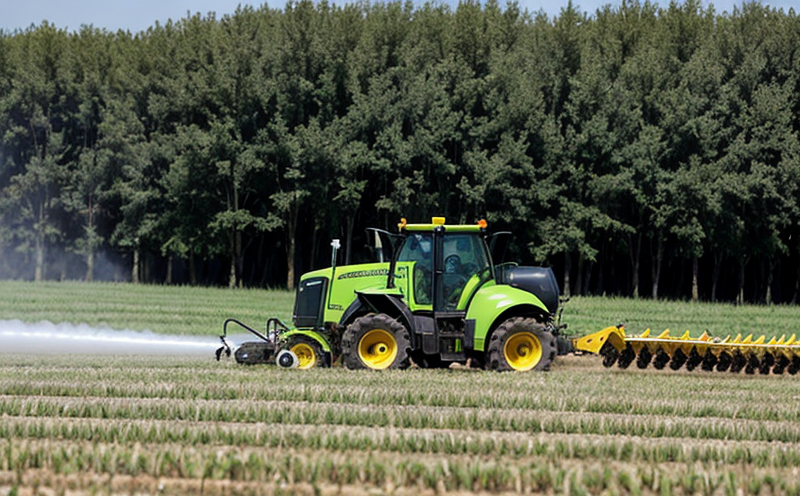Alachlor Residue Testing in Crops
Alachlor, a widely used herbicide, is critical to agricultural productivity. However, its presence in crops can pose significant risks if not managed correctly. Proper residue testing ensures compliance with regulatory standards and protects the environment from potential contamination. This service focuses on providing accurate and reliable testing for alachlor residues in various crops.
Alachlor is primarily used to control broadleaf weeds and grasses, particularly in corn and sorghum fields. It can also be applied to other crops such as soybeans, wheat, and rice. The half-life of alachlor varies depending on environmental conditions but typically ranges between 21 and 56 days. Residue persistence is a concern because it can accumulate over multiple growing seasons.
Testing for alachlor residues involves several key steps to ensure accurate results:
- Sample Collection: Samples must be collected from representative areas of the field or storage facility, ensuring they reflect the overall condition of the crop.
- Preservation: Samples are often preserved with acids or refrigerated to prevent degradation before analysis.
- Extraction and Cleanup: The sample is then extracted using solvents like acetonitrile, followed by a cleanup process to remove interfering substances.
- Instrumentation: High-performance liquid chromatography (HPLC) coupled with mass spectrometry (MS/MS) is commonly used for quantification. This ensures high sensitivity and selectivity necessary for detecting low levels of alachlor residues.
- Validation: The method must be validated to ensure accuracy, precision, and linearity over the expected range of concentrations.
- Reporting: Results are reported according to international standards such as ISO 18567-2:2019 for HPLC/MS/MS methods.
The primary goal is to ensure that alachlor levels in crops do not exceed the maximum residue limits (MRLs) set by regulatory bodies like the FAO and EPA. Failure to adhere to these limits can lead to contamination of food products, environmental damage, and potential legal consequences.
Regulatory Compliance: Many countries have established MRLs for alachlor in various crops. For example:
| Crop | MRL (mg/kg) |
|---|---|
| Corn | 0.3 |
| Soybeans | 1.5 |
| Rice | 2.0 |
Our laboratory adheres strictly to these standards and provides detailed reports that meet international requirements.
Industry Applications
The demand for accurate alachlor residue testing is driven by several factors:
- Agricultural Efficiency: Farmers rely on precise testing to optimize the use of herbicides and prevent overapplication.
- Consumer Safety: Ensuring that food products are free from harmful residues protects public health.
- Environmental Protection: Minimizing the environmental impact by preventing contamination is crucial for sustainable agriculture.
The testing process covers various crops including corn, soybeans, wheat, rice, and others. The table below highlights specific applications:
| Crop | Purpose of Testing |
|---|---|
| Corn | To ensure compliance with MRLs for export markets. |
| Soybeans | To meet stringent import regulations in Europe and Asia. |
| Rice | To comply with domestic standards and international trade agreements. |
| Wheat | To ensure the quality of grain before processing into flour or other products. |
In summary, accurate alachlor residue testing is essential for maintaining agricultural productivity while ensuring compliance with global standards and protecting both human health and the environment.
Why Choose This Test
The importance of alachlor residue testing cannot be overstated. Here are several reasons why our service stands out:
- Precision and Accuracy: Our lab uses state-of-the-art HPLC/MS/MS technology to provide precise results.
- Compliance Assurance: We ensure that all tests meet international standards, guaranteeing compliance with regulatory requirements.
- Speedy Turnaround Times: We understand the urgency of time-sensitive projects and strive to deliver results within 7-10 business days.
- Expertise and Experience: Our team consists of highly trained professionals specializing in agricultural testing, ensuring reliable outcomes.
- Cost-Effective Solutions: While maintaining high standards, we offer competitive pricing that fits your budget.
- Detailed Reporting: Comprehensive reports are provided to give you a clear understanding of the results and their implications.
In addition to these benefits, our service also offers flexibility in sample types and volumes, allowing us to accommodate diverse client needs. We pride ourselves on providing a seamless experience from initial consultation through final report delivery.
Competitive Advantage and Market Impact
Accurate alachlor residue testing plays a pivotal role in several aspects of the agricultural sector, contributing significantly to competitive advantage:
- Enhanced Reputation: By ensuring compliance with MRLs, our clients enhance their reputation among consumers and buyers.
- Informed Decision-Making: Reliable testing data empowers farmers and processors to make informed decisions regarding pesticide use and crop handling.
- Increased Market Access: Meeting regulatory standards opens up new markets domestically and internationally, boosting business opportunities.
- Potential for Innovation: Understanding residue levels can lead to innovations in pest management practices and sustainable farming techniques.
In the competitive landscape of agriculture, maintaining high-quality produce is paramount. Our service not only helps achieve this but also contributes positively to market dynamics by fostering trust and reliability.





